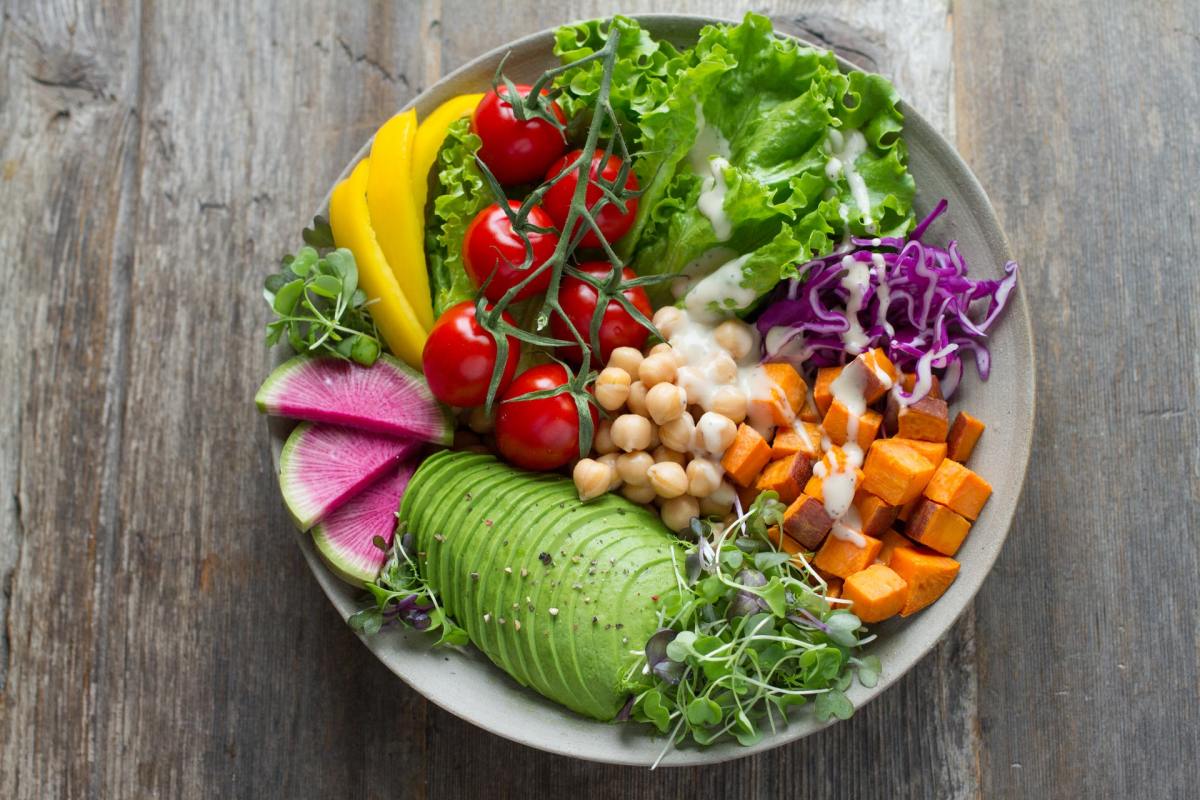Embark on a culinary journey into the vibrant world of flexitarian eating! This guide unveils the secrets to crafting delicious and nutritious meals that seamlessly blend the benefits of plant-based and animal-based foods. Discover how to achieve a balanced approach, maximizing flavor and health without strict dietary limitations. We’ll explore the principles of flexitarian eating, mastering macronutrient balance, and unlocking the art of creating vibrant, flavorful meals that nourish your body and delight your taste buds. Get ready to transform your kitchen into a haven of healthy and satisfying flexitarian cuisine.
From understanding the core principles of flexitarian diets and their advantages compared to vegetarian and vegan options, we’ll delve into the practicalities of meal planning and preparation. We’ll equip you with the knowledge to confidently navigate the world of macronutrients, ensuring your meals are packed with the right balance of protein, carbohydrates, and healthy fats. Learn to harness the power of fruits and vegetables, creating colorful and flavorful dishes that are both visually appealing and nutritionally complete. We’ll provide step-by-step recipes, complete with vivid descriptions to guide you through the cooking process, ensuring each meal is a culinary masterpiece.
Building Balanced Meals
A flexitarian diet, characterized by predominantly plant-based eating with occasional inclusion of meat and other animal products, necessitates careful consideration of macronutrient balance to ensure optimal health and well-being. Achieving this balance involves understanding the roles of protein, carbohydrates, and fats and strategically incorporating food sources rich in each. Ignoring this balance can lead to nutritional deficiencies or unwanted weight fluctuations.
Macronutrient Balance in Flexitarian Eating
Maintaining a balanced intake of protein, carbohydrates, and fats is crucial for a successful and healthy flexitarian diet. Protein provides the building blocks for tissues and enzymes, carbohydrates offer sustained energy, and fats support hormone production and nutrient absorption. A well-proportioned combination of these macronutrients fuels physical activity, cognitive function, and overall bodily processes. The ideal ratio can vary depending on individual needs and activity levels, but a generally recommended approach is to prioritize complex carbohydrates, lean protein sources, and healthy fats.
High-Protein Plant-Based Sources
Numerous plant-based foods offer substantial protein content, making it easy to meet daily protein requirements without relying solely on animal products. These sources are not only packed with protein but often provide a wealth of additional nutrients like fiber, vitamins, and minerals. Incorporating a variety of these sources ensures a well-rounded nutritional profile.
Macronutrient Comparison of Flexitarian Meal Components
The following table provides a comparative overview of the macronutrient content (per 100g serving) of common flexitarian meal components. Remember that these values can vary slightly depending on factors such as preparation methods and specific varieties.
| Food | Protein (g) | Carbohydrates (g) | Fat (g) |
|---|---|---|---|
| Lentils (cooked) | 9 | 20 | 1 |
| Quinoa (cooked) | 4 | 21 | 2 |
| Chicken Breast (cooked) | 30 | 0 | 3 |
| Tofu (firm) | 8 | 2 | 5 |
Incorporating Fruits and Vegetables
Fruits and vegetables are the vibrant cornerstones of a balanced flexitarian diet, providing an array of essential vitamins, minerals, and fiber crucial for overall health and well-being. Their naturally low calorie density contributes to weight management, while their rich antioxidant content combats cellular damage and reduces the risk of chronic diseases. Including a generous portion of these colorful powerhouses ensures a diet rich in nutrients and satisfying textures.
The incorporation of fruits and vegetables isn’t merely about adding nutrients; it’s about enhancing the sensory experience of your meals. Their diverse colors, flavors, and textures add visual appeal and culinary excitement, making healthy eating a delightful adventure. A flexitarian approach allows for creative combinations, blending the natural sweetness of fruits with the savory depth of vegetables and the satisfying protein sources that flexitarian eating offers. This leads to a more enjoyable and sustainable dietary pattern.
A Vibrant Flexitarian Salad Recipe
This recipe showcases the beauty and nutritional benefits of a colorful, flexitarian-friendly salad. Imagine a bowl brimming with jewel-toned ingredients, a symphony of textures and tastes.
Name: Mediterranean Harvest Salad
Yields: 4 servings
Prep time: 20 minutes
Ingredients:
- 5 oz mixed greens (e.g., romaine, spinach, arugula), a lush, dark green base providing a foundation of nutrients.
- 1 cup cherry tomatoes, halved, their vibrant red adding a burst of sweetness and antioxidants.
- 1/2 cup cucumber, thinly sliced, offering a refreshing crunch and hydrating properties.
- 1/2 cup bell peppers (assorted colors), diced, contributing sweetness and a rainbow of colors.
- 1/2 cup Kalamata olives, halved, their briny saltiness adding a savory depth.
- 1/2 cup crumbled feta cheese, providing a salty, tangy contrast and a good source of calcium.
- 4 oz grilled halloumi cheese, sliced, offering a satisfyingly firm, salty, and slightly squeaky texture.
- Dressing: 2 tbsp olive oil, 1 tbsp lemon juice, 1 tsp Dijon mustard, salt and pepper to taste – a simple yet flavorful dressing that binds the salad together.
Instructions:
- Combine mixed greens, cherry tomatoes, cucumber, bell peppers, and olives in a large bowl. The visual contrast of the ingredients is striking.
- Grill or pan-fry the halloumi until golden brown and slightly charred. The halloumi adds a substantial protein element.
- In a small bowl, whisk together olive oil, lemon juice, Dijon mustard, salt, and pepper. The dressing should be emulsified and glossy.
- Arrange the grilled halloumi over the salad. The warm halloumi contrasts nicely with the cool vegetables.
- Crumble the feta cheese over the salad. The feta adds a creamy, salty counterpoint.
- Drizzle the dressing over the salad and toss gently to combine. The dressing should coat the salad evenly.
Seasonal Fruits and Vegetables for Flexitarian Meals
Choosing seasonal produce ensures optimal flavor, nutritional value, and lower environmental impact. The following list provides examples of fruits and vegetables that are readily available during different seasons in temperate climates, though the exact timing may vary based on location and microclimate.
Spring: Asparagus, vibrant green spears; strawberries, juicy and sweet; peas, tender and bright green; radishes, with their peppery bite.
Summer: Tomatoes, bursting with flavor; zucchini and yellow squash, versatile and summery; corn on the cob, sweet and juicy; blueberries, bursting with antioxidants.
Autumn: Butternut squash, rich and creamy; Brussels sprouts, nutty and slightly bitter; apples, crisp and sweet; cranberries, tart and vibrant red.
Winter: Root vegetables such as carrots, parsnips, and sweet potatoes, offering sweetness and hearty texture; citrus fruits like oranges and grapefruits, packed with vitamin C; kale, hearty and nutritious; broccoli, a versatile cruciferous vegetable.
Recipe Development and Step-by-Step Guides

Crafting delicious and balanced flexitarian meals involves understanding the interplay of flavors and textures. This section provides detailed, step-by-step guides for creating three distinct flexitarian recipes: a vibrant stir-fry, a hearty lentil soup, and a satisfying pasta dish. Each recipe emphasizes fresh ingredients and balanced nutrition.
Flexitarian Stir-Fry
Imagine a symphony of colors and aromas. This stir-fry is a vibrant showcase of fresh vegetables and protein, offering a light yet satisfying meal.
- Preparation: Begin by prepping your vegetables. Picture vibrant red bell peppers sliced into thin strips, tossed with glistening broccoli florets, and fragrant chunks of firm tofu, pressed to remove excess water. Imagine the earthy scent of sliced shiitake mushrooms and the crisp snap of snow peas. Finely mince two cloves of garlic and a thumb-sized piece of ginger, their pungent aromas already filling the kitchen.
- Stir-frying: Heat a tablespoon of sesame oil in a wok or large skillet over medium-high heat. The oil shimmers, ready to embrace the ingredients. Add the tofu and stir-fry for 5 minutes until lightly browned, its edges crisping beautifully. Next, add the garlic and ginger, their fragrance intensifying with the heat. Stir for 30 seconds until fragrant.
- Vegetables: Add the bell peppers, broccoli, shiitake mushrooms, and snow peas to the wok. Stir-fry for another 5-7 minutes, until the vegetables are tender-crisp, retaining their vibrant colors and slight crunch. The air is now thick with the sweet scent of peppers and the earthy aroma of mushrooms.
- Sauce: In a small bowl, whisk together 2 tablespoons of soy sauce, 1 tablespoon of rice vinegar, 1 tablespoon of honey, and a teaspoon of cornstarch. Pour the sauce over the vegetables and tofu, stirring constantly until the sauce thickens and coats everything evenly. The glossy sauce clings to each piece, adding a touch of sweetness and savory depth.
- Serving: Serve the stir-fry hot over brown rice or quinoa, garnished with chopped green onions for a fresh, vibrant finish. The finished dish is a colorful explosion of flavors and textures, a perfect example of a balanced flexitarian meal.
Flavorful Flexitarian Lentil Soup
This lentil soup is a comforting and nutritious meal, its aroma a warm hug on a chilly evening. The textures shift from the firm lentils to the creamy broth, creating a satisfying culinary experience.
- Sautéing Aromatics: Begin by finely chopping one onion, two carrots, and two celery stalks. Imagine the sweet scent of the carrots mingling with the pungent aroma of the onions as they soften in a tablespoon of olive oil over medium heat. The kitchen fills with a comforting, home-cooked aroma.
- Adding Lentils and Vegetables: Add one cup of brown or green lentils, rinsed, to the pot along with four cups of vegetable broth. Stir in a teaspoon of dried thyme and a bay leaf, their earthy fragrances weaving into the evolving aroma. The lentils plump and soften in the simmering broth.
- Simmering: Bring the soup to a boil, then reduce heat and simmer for 30-40 minutes, or until the lentils are tender but not mushy. The broth deepens in color and richness, the aroma becoming more complex and inviting with each passing minute.
- Seasoning and Blending: Season the soup with salt and pepper to taste. You can optionally blend a portion of the soup with an immersion blender for a creamier texture, leaving some lentils whole for added texture contrast. The blended portion adds a smooth, velvety element to the overall texture.
- Serving: Serve the soup hot, garnished with a dollop of plain yogurt or a sprinkle of fresh parsley. The final product is a hearty, flavorful soup with a delightful balance of textures and aromas, showcasing the versatility of lentils in a flexitarian diet.
Flexitarian Pasta Dish
This pasta dish offers a delightful combination of textures and flavors, balancing the heartiness of pasta with the freshness of vegetables and the richness of a creamy sauce.
- Preparing Ingredients: Cook your pasta according to package directions. While the pasta cooks, sauté finely chopped zucchini, yellow squash, and cherry tomatoes in olive oil until slightly softened. Imagine the sweet aroma of the summer vegetables mingling with the fragrant olive oil. Their vibrant colors add a visual appeal to the dish.
- Creating the Sauce: In a separate pan, whisk together ½ cup of nutritional yeast, ¼ cup of cashew cream (or other plant-based cream), 2 tablespoons of lemon juice, and a pinch of garlic powder. The sauce develops a creamy, slightly tangy consistency, with the nutritional yeast lending a cheesy flavor.
- Combining Ingredients: Once the pasta is cooked, drain and add it to the pan with the sautéed vegetables. Pour the creamy sauce over the pasta and vegetables, tossing gently to coat everything evenly. The sauce clings to the pasta, creating a smooth, creamy texture that contrasts with the slightly firmer vegetables.
- Garnishing and Serving: Garnish with fresh basil leaves and a sprinkle of red pepper flakes for a touch of heat. The finished dish is a vibrant and flavorful pasta creation, perfect for a satisfying and balanced flexitarian meal. The aroma is a harmonious blend of creamy, tangy, and slightly spicy notes.
Mastering the art of balanced flexitarian meals is not just about following recipes; it’s about embracing a flexible and fulfilling approach to healthy eating. By understanding the principles of macronutrient balance, incorporating a rainbow of fruits and vegetables, and mastering efficient meal planning strategies, you’ll unlock a world of delicious and nutritious possibilities. With this guide as your culinary compass, you’re empowered to create flavorful, satisfying meals that align perfectly with your lifestyle and health goals. So, embark on this exciting culinary adventure, and discover the joy of balanced flexitarian eating!
Query Resolution
What are some common pitfalls to avoid when transitioning to a flexitarian diet?
Common pitfalls include neglecting sufficient protein intake, relying too heavily on processed plant-based foods, and not planning meals adequately, leading to reliance on unhealthy convenience options.
How can I ensure I’m getting enough iron and vitamin B12 on a flexitarian diet?
Focus on iron-rich plant sources like lentils and spinach, and consider fortified foods or supplements for vitamin B12, especially if you significantly reduce animal products.
Are there any specific tools or apps that can help with flexitarian meal planning?
Many meal planning apps and websites allow you to filter recipes based on dietary restrictions, including flexitarian options. Explore options that let you track macronutrients and customize your meal plans.
Can I still eat out while following a flexitarian diet?
Yes! Many restaurants offer vegetarian or adaptable options. When dining out, carefully examine menus, ask about ingredient substitutions, and don’t hesitate to communicate your dietary preferences.


